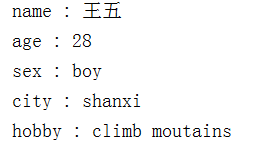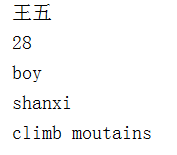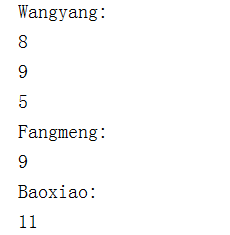一、如何定义字典。
person_message ={
'name':'zhangsan',
'age':21,
'sex':'boy',
'city':'shanxi'
}
print(person_message)
执行结果:

二、修改字典中的值。
person_message ={
'name':'王五',
'age':28,
'sex':'boy',
'city':'shanxi'
}
print(person_message)
执行结果:

三、增加字典中的值
person_message ['hobby']='climb moutains'
print(person_message)
执行结果:

四、访问字典中的值
print(person_message['name'])
执行结果:

五、删除键-值对
del(person_message['name'])
print(person_message)
执行结果:

六、遍历字典
1、遍历所有键-值对
for key ,value in person_message.items():
print(key,':',value)
执行结果:

2、遍历所有键
for key in person_message.keys():
print(key)
执行结果:

3、遍历所有的值
for value in person_message.values():
print(value)
执行结果:

4、按顺序遍历字典中的键
for key in sorted(person_message.keys()):
print(key)
执行结果:

七、嵌套
1、列表里嵌套字典
alien_ 0 = {'color': 'green', 'points': 5}
alien_ 1 = {'color': 'yellow', 'points': 10}
alien_ 2 = {'color': 'red', 'points': 15}
aliens = [alien_ 0, alien_ 1, alien_ 2]
for alien in aliens:
print( alien)
执行结果:

2、字典里嵌套列表
favourite_numbers = {
"Wangyang":['8','9','5'],
"Fangmeng":['9'],
"Baoxiao":['11'],
}
for name,numbers in favourite_numbers.items():
print(name+':')
for number in numbers:
print(number)
执行结果:

3、字典嵌套字典
cities = {
'Chengdu': {
'country': 'China',
'population': '1390 million',
'fact': 'so many people'
},
'Paris': {
'country': 'French',
'population': 'six-seven million',
'fact': 'peple are very romantic'
},
'London': {
'country': 'England',
'population': '66 million',
'fact': 'The men is very gentlemanly'
}
}
for city, city_information in cities.items():
print(' ' + city + ':')
for city, value in city_information.items():
print(city + ': ' + value)
执行结果:
